ifm efector OGS280
Photoelectric sensor, thru-beam transmitter, 20m fixed range, 2wire DC, QD
Mfr. Part #: OGS280 / RS Stock #: 71553539

Image may be a representation. See specs for product details.
Price
Qty.
Standard Price
1
$87.36
5
$82.99
10
$81.24
25
$79.50
50
$77.75
100
$76.00
Additional Inventory
On order:
2
Manufacturer Lead Time:
3 weeks

Estimated manufacturer lead time is for quantities greater than shown above.
Product Specifications
Product Attribute
Attribute Value
Search
Alternate Mfr Part Number
OGS-OOKG/US/CUBE
Measurement Range
20 m
Overview
The transmitter and receiver are packaged in the same housing and mounted opposite a reflector. Light is sent from the transmitter lens, bounces off the reflector and returns to the receiver lens. As with thru-beam sensors, the output changes state when a target interrupts the beam and starves the receiver of light. As long as the target is large and solid enough to break the effective beam, the color, shape, angle, reflectivity and surface finish will not affect the application. This makes them more reliable than diffuse sensors, which depend on light reflecting off the target. Automation technology can no longer be imagined without photoelectric sensors as "artificial eyes". They are used where a reliable and non-contact detection of the exact position of objects is required. The material of the object to be detected is of no importance. Compared to inductive sensors, photoelectric sensors have a much greater sensing zone. Through-beam sensors are distinguished by a long range. The system consists of two separate components: a transmitter and a receiver. The light only covers one way (from the transmitter to the receiver). Adverse effects in the applications, such as dust in the air, dirt on the lenses, steam or mist do not immediately interfere with the system. For retro-reflective sensors the transmitter and receiver are incorporated into one housing. By means of a reflector the transmitted light is returned to the receiver. Retro reflective sensors without polarization filter operate with infrared light, systems with polarization filter with visible red light. Diffuse reflection sensors are used for the direct detection of objects. The transmitter and receiver are integrated into one housing. The transmitter emits light which is reflected by the object to be detected and seen by the receiver. The light reflection from an object is evaluated. Therefore additional functional components (such as reflectors for retro-reflective sensors) are not needed for the operation of a diffuse reflection sensor.
Features:
Reliable detection of tiny objects
Robust stainless steel housing for use in harsh industrial environments
Very long range
Visible red light for simple alignment
Excellent price/performance ratio
Features:








 Bulk pricing available
Bulk pricing available
